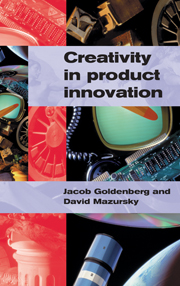Book contents
- Frontmatter
- Contents
- Preface
- Acknowledgements
- Introduction: characterization and illustration of Creativity Templates
- Part I Theoretical framework
- Part II The Creativity Templates
- 4 The Attribute Dependency Template
- 5 The Forecasting Matrix
- 6 The Replacement Template
- 7 The Displacement Template
- 8 The Component Control Template
- Part III A closer look at Templates
- Part IV Validation of the Templates theory
- Index
4 - The Attribute Dependency Template
from Part II - The Creativity Templates
Published online by Cambridge University Press: 03 May 2010
- Frontmatter
- Contents
- Preface
- Acknowledgements
- Introduction: characterization and illustration of Creativity Templates
- Part I Theoretical framework
- Part II The Creativity Templates
- 4 The Attribute Dependency Template
- 5 The Forecasting Matrix
- 6 The Replacement Template
- 7 The Displacement Template
- 8 The Component Control Template
- Part III A closer look at Templates
- Part IV Validation of the Templates theory
- Index
Summary
This template was illustrated briefly in the introduction: the Polo Harlequin®, Domino's pizza delivery and the dynamization of the credit in the lighthouse are all examples of ideas that share the structure of this Template. In this chapter we will focus on this Template and on ways to implement it successfully in new product ideation.
An antenna in the snow – a detailed illustration
The following example shows how illusive creative ideas may often be. A company specializing in the production of transmission and reception sets participated in a bid for the production of military receiving antennas in a region where winter temperatures reach a low of −40°C. The company itself is located in a warm climate where even light snow is a rare event. It may be for this reason that the company engineers forgot to take into account a common phenomenon in the target market: The accumulation of ice on the antenna causes an overload on the pole, which may cause it to buckle down and collapse (see Figure 4.1). They therefore designed a light pole, which was not quite suited for the task. Ironically, because of the importance assigned to the weight issue (the pole should be light as it had to be carried by a team of three soldiers), the army accepted this bid.
- Type
- Chapter
- Information
- Creativity in Product Innovation , pp. 59 - 75Publisher: Cambridge University PressPrint publication year: 2002

